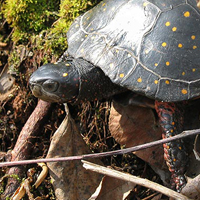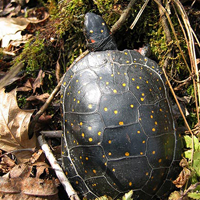Spotted turtle
Scientific name: Clemmys guttata



Cover photos credit: Rob Tervo
Status
Endangered
“Endangered” means the species lives in the wild in Ontario but is facing imminent extinction or extirpation.
Date added to the Species at Risk in Ontario List
The Spotted turtle was already assessed as endangered when the Endangered Species Act took effect in 2008. It was re assessed as endangered in 2015.
Read the report (PDF)
What it looks like
The Spotted turtle is one of Ontario’s smallest turtles with a shell that is rarely more than 13 centimetres long.
It is easily recognized by its smooth black shell, which is spattered with bright yellow-orange spots. The head and limbs are also black with yellow-orange markings. These turtles eat aquatic insects, crustaceans and worms.
Where it lives
The Spotted turtle is semi-aquatic and prefers ponds, marshes, bogs and even ditches with slow-moving, unpolluted water and an abundant supply of aquatic vegetation.
They are found in different types of wetlands throughout the province, depending on the types of habitats that are available. Females dig their nests in sunny locations where there is not a lot of woody vegetation.
This species usually hibernates in wetlands or seasonally wet areas associated with structures including overhanging banks, hummocks, tree roots, or aquatic animal burrows.
Where it’s been found in Ontario
In Canada, the Spotted turtle is found primarily in Ontario along the north shore of Lake Erie, in the Georgian Bay area and in scattered locations throughout southern and eastern Ontario. Over the last 30 to 40 years, Spotted turtles have declined significantly and are no longer found at several sites in southern Ontario.
It is difficult to estimate the Ontario population size, but recent data suggests there are approximately 2000 individual Spotted turtles spread throughout several small, scattered populations. Of the handful of known populations, only a few are large enough to ensure long-term survival.
What threatens it
The most significant threats are habitat destruction and illegal collection for the pet trade. Activities that alter the water table during the winter, such as digging a ditch along a road, can wipe out an entire population.
Nest predation, pollution, and road mortality have also contributed to its decline. Since this turtle is slow to reach sexual maturity (up to 15 years) and suffers high egg and juvenile mortality, population recovery may be slow.
Action we are taking
Endangered Species and their general habitat are automatically protected.
Recovery strategy
A recovery strategy advises the ministry on ways to ensure healthy numbers of the species return to Ontario.
Read the executive summary and the full document (December 5, 2019).
Government response statement
A government response statement outlines the actions the government intends to take or support to help recover the species.
Read the government response statement (September 8, 2020)
Habitat protection
General Habitat Protection - June 30, 2013
What you can do
Report a sighting
The Ministry of Natural Resources and Forestry tracks species at risk such as the Spotted turtle. Report a sighting of an endangered animal or plant to the Natural Heritage Information Centre. Photographs with specific locations or mapping coordinates are always helpful.
Volunteer
Volunteer with your local nature club or provincial park to participate in surveys or stewardship work focused on species at risk.
Be a good steward
- private land owners have a very important role to play in species recovery; If you find Spotted turtle on your land, you may be eligible for stewardship programs that support the protection and recovery of species at risk and their habitats
- every year turtles must cross busy roads to get to their nesting sites; watch for turtles on the roads, especially between May and October; some municipalities post road signs in areas where turtles are common
- the Spotted turtle is a common target of the illegal pet and food trade; never buy turtles that have been caught in the wild and never buy a native species of any kind that’s being sold as a pet
Report illegal activity
Report any illegal activity related to plants and wildlife to
Quick facts
- the Spotted turtle is relatively social. It congregates to breed in the spring and also often hibernates in groups. Females even nest together in some sites
- Spotted turtles often emerge from hibernation when there is still partial ice cover
- most female and male turtles look a little bit different; in the case of Spotted turtles, females have bright orange eyes and chins whereas males’ are dark brown or black